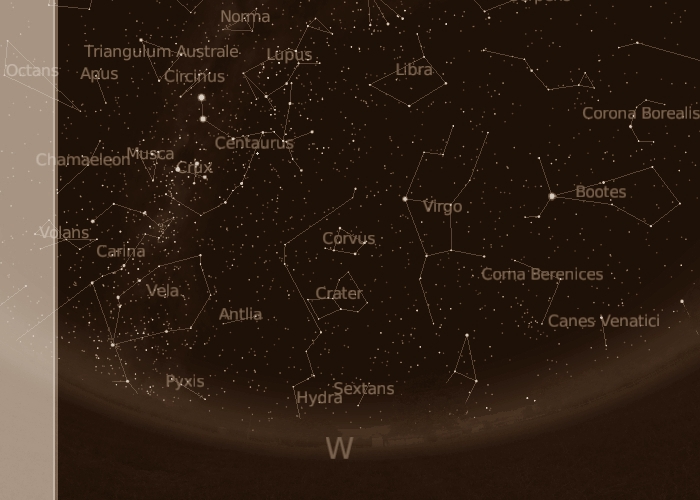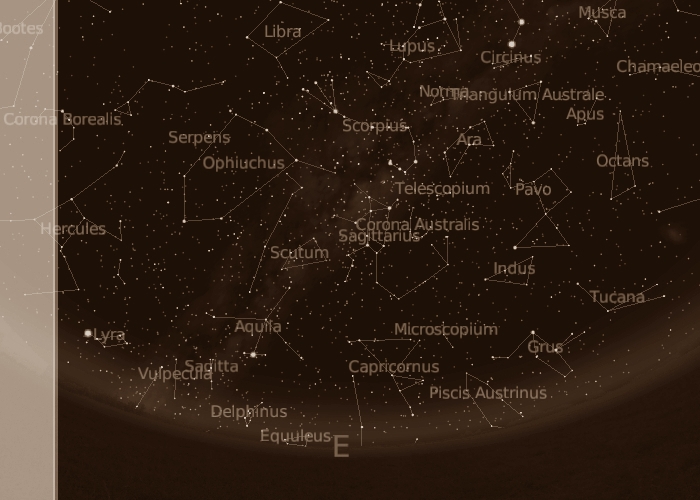Western Horizon
Eastern Horizon
Precisions About Daylight Saving Time (DST) Adjustments
![]()
Western Horizon
Eastern Horizon
Precisions About Daylight Saving Time (DST) Adjustments

We're in June. That's to say that the winter solstice is occurring this month, for the southern hemisphere. Hence the skies we are seeing are transtional ones, from fall to winter! The whole southwestern part of the western horizon is filled with the Milky Way-embedded, typically southern constellations, which are a distinctive features of the southern skies, spanning then, from Vela, the Ship's Sails to the Pointers, high, via Crux, the Southern Cross. A fine view. The Pointers are both the stars Alpha and Beta Centauri. Beta Centauri also is known under the name of 'Agena'. A part of Hydra, the Hydra is seen, with Crater, the Cup, and Corvus, the Crow anchoring along. The bright star, high, is Spica, of constellation Virgo, the Virgin, as the one to its right is Arcturus, of Bootes, the Herdsman. The deep-sky galaxy fields of Coma Berenices and Virgo are now unluckily tending low. The rear stars of Leo, the Lion, are seen low. The long band of Milky Way-embedded constellations is continuing South, as both the Magellanic Clouds are seen above the horizon, low. to a printer-friendly chart
West for the tropics. West for the mid-northern latitudes

East, now! The whole southeastern part of the sky is the location for typically southern constellations, like Pavo, the Peacok, Indus, the Indian, or Microscopium, the Microscope. Grus, the Crane is still low. A major view, now high, is the center of our Milky Way Galaxy, in Sagittarius, the Archer. Here the bulge of yellowish, old stars is to be found, along with the famed supermassive galactic black hole. A black hole is a place of an intense, relativistic gravity, whence nothing can get out, not even light. This one has the width of the orbit of Mercury! scorpius, the Scorpion is high, as Capricornus, the Goat, one zodiacal constellation, is rising! Ophiuchus, the Serpent Holder, with its two serpents, is high, northeast, as it's a good time to spot, really northeast, Hercules, the Heroe, albeit low, somehow. Hercules is a quadrilateral of stars, with extensions, as it's harbouring the famed M13, a globular cluster. A last look, northeast, low, as you'll be able to spot, mostly, Altair, of Aquila, the Eagle. The bright star to its left, on the chart, is Vega, of Lyra, the Lyra. Along with Deneb, of Cygnus, the Swan, those stars are composing the famed Summer Triangle, a distinctive feature of the summer skies in the northern hemisphere. to a printer-friendly chart
East for the tropics. East for the mid-northern latitudes
Some countries in the southern hemisphere don't have any Daylight Saving Time system. Some do have one. According to the policy of our site, our sky charts include a one-hour DST shift for the period September to March. Should your DST period differ, just adjust the charts. Should you not have any DST, take in account that one-hour DST shift we are applying September-March
For more details upon whether you country is applying, and when, a DST, please check a search engine on the Internet, for example!
Website Manager: G. Guichard, site 'Amateur Astronomy,' http://stars5.6te.net. Page Editor: G. Guichard. last edited: 12/28/2010. contact us at ggwebsites@outlook.com